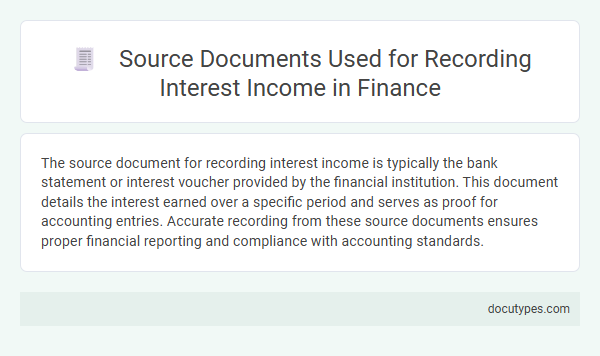The source document for recording interest income is typically the bank statement or interest voucher provided by the financial institution. This document details the interest earned over a specific period and serves as proof for accounting entries. Accurate recording from these source documents ensures proper financial reporting and compliance with accounting standards.
Definition of Interest Income in Finance
Interest income in finance refers to the earnings generated from lending money or investing in interest-bearing assets such as bonds, savings accounts, or loans. The source document for recording interest income is typically the interest statement or coupon payment receipt provided by banks or financial institutions. You use these documents to accurately record and verify the interest earned during a specific accounting period.
Importance of Source Documents for Interest Income
Source documents for recording interest income include bank statements, loan agreements, and interest payment receipts. These documents provide verifiable evidence of the amount and timing of interest earned, ensuring accurate financial records. Maintaining proper source documents is crucial for compliance, auditing, and effective financial management, helping you track your true income sources reliably.
Common Types of Source Documents for Interest Income
The source document for recording interest income provides verified details essential for accurate financial records. These documents serve as proof of earned interest from various financial instruments.
Common types of source documents for interest income include bank statements, which detail interest earned on savings or checking accounts. Another frequent document is bond interest coupons, showing payments received from bond investments.
Bank Statements as Evidence of Interest Income
| Source Document | Description | Role in Recording Interest Income |
|---|---|---|
| Bank Statements | Official monthly or periodic statements issued by banks that detail account transactions, including deposits, withdrawals, and interest credited. | Primary evidence for verifying and recording interest income earned from savings accounts, fixed deposits, or other interest-bearing instruments within financial records. |
| Interest Certificates | Documents issued by financial institutions summarizing the total interest earned over a specific period. | Supports reconciliation of interest income reported on bank statements and provides documentation for tax reporting purposes. |
| Passbooks | Physical or digital records maintained by the account holder detailing transactions, including interest credits. | Provides historical reference for interest entries and supports periodic financial reviews. |
Loan Agreements and Interest Earned
What is the source document for recording interest income related to loans? The primary source document for recording interest income is the loan agreement, which outlines the terms and interest rates. Your interest earned is calculated based on these terms and is supported by periodic statements or payment receipts.
Fixed Deposit Receipts as Source Documents
Fixed Deposit Receipts (FDRs) serve as essential source documents for recording interest income in financial accounting. These receipts provide detailed information about the principal amount, interest rate, tenure, and interest earned during the fixed deposit period.
Your interest income is verified and recorded based on the data from FDRs, ensuring accuracy and compliance with accounting standards. FDRs also help in reconciling bank statements and preparing financial reports related to investment income.
Interest Certificates from Financial Institutions
The primary source document for recording interest income is the Interest Certificate issued by financial institutions. This certificate details the interest earned on savings accounts, fixed deposits, or other investment products during a specific period.
Interest Certificates provide an official and verifiable record of the income accrued, including the principal amount, interest rate, and the exact interest earned. These documents are essential for accurate financial reporting and tax filing purposes. Companies and individuals use Interest Certificates to reconcile their accounting records and ensure compliance with regulatory requirements.
Dividend and Interest Income Slips
The primary source document for recording interest income is the interest income slip provided by financial institutions. Dividend income is documented through dividend income slips issued by companies or brokers.
- Interest Income Slip - This document details the amount of interest earned on savings accounts, bonds, or other interest-bearing instruments during a specific period.
- Dividend Income Slip - It records dividend payments received from investments in stocks or mutual funds and is essential for accurate income reporting.
- Importance for Your Records - Retaining these slips ensures precise calculation and reporting of interest and dividend income on your financial statements or tax returns.
Recording and Filing Source Documents for Compliance
The source document for recording interest income is crucial for accurate financial reporting and compliance. Proper filing ensures traceability and supports audit processes.
- Interest Statement - This document from banks or financial institutions details earned interest within a specific period.
- Deposit Slips - These confirm the receipt of interest payments into business or personal accounts for record verification.
- Transaction Receipts - Receipts from financial transactions provide proof of interest credited and support reconciliation.
Maintaining organized source documents for interest income strengthens compliance with financial regulations and auditing standards.
What Is the Source Document for Recording Interest Income? Infographic

